Ch. 7 (unsoundness)
1/71
Earn XP
Name | Mastery | Learn | Test | Matching | Spaced |
|---|
No study sessions yet.
72 Terms
often an unsoundness is also a _____
blemish
allergy
heightened sensitivity to a particular substance that does not affect the majority of the group
anti-inflammatory
drug that can be used to lessen pain and decrease inflammation
atrophy
a wasting away or shrinking of muscle
bars
the structure that keeps the hoof wall from overextending. It is a support structure that angles forward from the hoof wall
blemish
a blemish is unattractive but does not and is not apt to interfere with a horses performance
boot
a device that can be applied to the foot to prevent it from injuring the elbow
bowed tendons
caused by severe strain and ear and shows up as a thickened enlargement of the tendon that occupies the posterior space in the cannon region between the knee and ankle or hock and ankle. it involves any or all groups of tendons and ligaments but is usually the superflexor tendon the deep flexor tendon and the suspensory ligament
calcification
replacement of the original hard parts of an nail by calcium carbonate
calks
grips on heels and the outside of the front shoes of horses designed to give better footing and prevent slipping

collar
part of a draft horses harness that is fitted over the shoulders that helps take the strain when a load is pulled
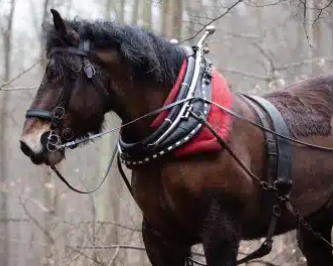
congenital
condition that exists at birth; acquired during the prenatal period
conservative treatment
a more reserved treatment for bone fractures in horses. The treatment consists of stall confinement, hand walking and anti inflammatory drugs to reduce pain and swelling
cribbing
when a horse grasps an object between their teeth and apply pressure, gradually gnawing the object away if its not metal
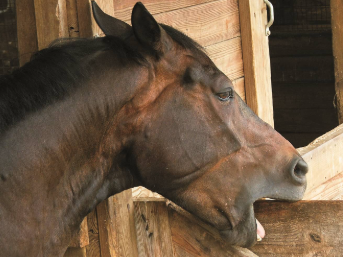
degree of finesse
determined with gaited and parade horses by how well they "move" off their hocks
fibrosis
thickening of affected skin
flexion tests
helps to determine the extent and location of a fracture or other problem of the leg
founder
also called laminitis. Any inflammation of the sensitive laminae under the horny walls of the hoof. All feet may be affected but the front feet are most susceptible
fracture
a break or crack in the bone
heaving
caused by loss of elasticity in the lungs resulting from a breakdown in the walls of a portion of the air cells. There is an extra contraction of the flank muscles during expiration
high ringbone
a bony enlargement on the pastern bones. It occurs at the pastern joint
hobble
a type of restraint used on horses in which either the front feet or hind feet are placed in straps to keep them from kicking or walking and wandering to far
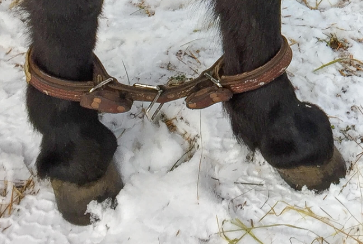
hock
the large joint halfway up the hind leg of a horse
hoof testers
a tool that picks up increased sensitivity commonly over the toe in a horses foot
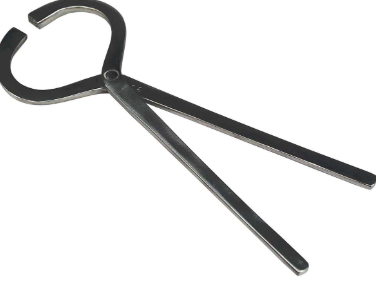
hydrotherapy
the application of cold water to the affected area
implants
devices used to repair a fracture usually in a long bone
laminitis
inflammation of the sensitive laminae under the horny wall of the hoof. All feet may be susceptible . Characterized by ridges running around the hoof (also known as founder)
lateral cartilages
elastic cartilages just under the skin and extending above the hoof on each side of he heel that serve as part of the shock absorbing mechanism
low ringbone
bony enlargement on the pastern bones. It occurs at the pastern-coffin bone joint at about the level of the cornet band
malocclusion
where the top and bottom teeth do not meet
ossify
cartilage being made into bone
patella
flat moveable bone at the front of the stifle joint of a horse
plates
type of horseshoe
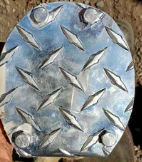
plumb line
when a weight is placed on the end of a string to measure the perpendicularity of something such as the leg of a horse
poll
area in-between ears
sensitization
allergic
shoe boil
also called capped elbow; soft flabby swelling a the point of the elbow usually caused by contact with a shoe when the horse is laying down
sidebones
when the lateral cartilages ossify, making the horse hard at the heels
sprain
any injury to a ligament usually occurring when a joint is carried through an abnormal range of motion
stifled
refers to a horse crippled by a displaced patella of the stifle joint
straight shoulders
confirmation problem that will give a horse a hard gait and possibly cause trouble keeping a saddle in place
tail board
used in the prevention of tail rubbing
ulcerate
to break skin or mucous membranes
umbilicus
the navel
unsoundness
any condition that interferes with or is apt to interfere with the function and performance of the horse
upright pasterns
straight vertical pastern bone -- conformation problem
vices
habits acquired by some horses that are subject to long periods of idleness. Hard work and freedom from closed spaces are preventatives
What is the difference between a blemish and unsoundness
a blemish differed from an unsoundness in that it is unattractive but does not and is not apt to interfere with a horses performance. It is usually an acquired physical problem that may not make the horse lame but may interfere the action of the horse. A blemish does not have to be an unsoundness
describe a common treatment for many of the problems that could develop into an unsoundness
rest to prevent further trauma
four common unsoundnesses associated with the head
Blindness, moon blindness (inflammation of the inner eye due to vitamin b deficiency, bad mouth (describes various jaw and or tooth misalignments), poll evil (fistula or sore that is difficult to heal resulting from a bruise or constant irritation to the poll, quiddor which is the dropping of feed while chewing
five common unsoundnesses and blemishes that can be found on the body
Fistulous withers ( inflammation affecting the withers similar to poll evil), Sweeney ( wasting away of shoulder muscle caused by damage to the nerve in the shoulder) Knocked down Hip ( Fracture of the ilium that results in lowering of the point of the hip) Scars ( marks left after the healing of a wound) Hernias ( generally the passage of a portion of intestine though an opening in the abdominal muscle)
Describe two types of unsound lungs
Roaring - paralysis or partial paralysis of the nerves that control the muscles of the vocal cords that causes a roaring sound when air is inhaled into the lungs
Heaving - caused by loss of elasticity in the lungs resulting from a breakdown in the walls of a portion of the air cells
Unsoundness or blemishes on the front or hind legs
Bog Spavin- soft fluctuating enlargement located at the upper part of the hack due to a distention of the joint capsule
Bone Spavin- bony enlargement at ht base and inside back border of the hock. Common in horses with sickle hocks or shallow joints
Bowed Tendons- apparent by thickening of the back surface of the leg immediately above the fetlock
Buck Kneed- because the knee is in front of the plumb line the leg is not straight
Bucked Shins- occur on the front top part of the cannon bone below the knee
Calf Kneed- deviation of knee joint behind the plumb line so the leg is not straight. puts lots of strain on the tendons and ligaments running down the back of the leg
Camped Out Leg- too far back and behind the plumb line. Often accompanied by upright pasterns and straight hocks
Capped Elbow- shoe boil, usually caused by injury from a shoe when lying down
Capped Hock- thickening of skin or large callus at the point of the hock
Chip Fractures- small fracture that breaks off the bones in the knee
Differentiate between a sprain and fracture
a sprain is any injury to a ligament and a fracture is a broken bone
Name the types of sprains
Grade I: Mild sprain that overstretches the ligament without tearing it
Grade II: Moderate sprain that partially tears the ligament
Grade III: Severe sprain that completely tears the ligament
Suspensory ligament injuries: The most common and serious ligament injuries in horses. They can occur from a single event or over time.
Inferior check ligament injuries: The least severe ligament injuries in horses. They can occur from excessive twisting or pivoting.
Name the types of fractures
Comminuted: A bone shatters into multiple pieces, often caused by a forceful blow
Chip: A small piece of bone breaks off, often in the fetlock, knee, or hock joint
Complete: The bone breaks into two separate pieces
Incomplete: The bone doesn't break all the way through
Articular: The fracture involves a joint surface
Apical: A fracture in the upper third of the sesamoid bone
Splint: A fracture in the second and fourth metacarpal and metatarsal bones
Carpal: A fracture in the accessory carpal bone, often caused by a fall
Condylar: A fracture that can be lateral or medial
Microfracture: A short fracture line, also known as a stress fracture
Hairline: A thin, incomplete fracture, also known as a stress fracture
Four conditions that predispose a horse to unsoundness
excessive strain or stress on a bone or muscle, injury, inherited condition or nutritional deficiency
Stable vices that affect usefulness
wind sucking, cribbing, weaving, stall walking, kicking, biting, tail rubbing, halter pulling
How to examine a horse for soundness
examine in natural surroundings iff possible, leading, in motion and an overall evaluation of the horse at rest
True or False: A blemish will always interfere with the performance of a horse
false a blemish may or may not affect the soundness of the horse
True or False: Poor confirmation has little to do with unsoundness
false it usually causes uneven stress and strain on the legs
True or False: Unsoundness interferes with the function and performance of the horse
true
True or False: Thrush is caused by unclean stables
true
True or False: Quittor is the name for horses dropping feed out of their mouth while they are chewing
false quittor is the festering of the foot anywhere along the border of the cornet band
An unsoundness in the lungs or respiratory tract includes ______, a partial paralysis of the nerves to the muscles of the vocal cords, and ______, a loss of elasticity in the lungs
roaring ; heaving
Six unsound conditions of the limbs
flat foot, founder, fractures, navicular, osselets, pointing
Two conditions caused by unclean stables
thrush (bacterial infection of the frog), grease heel (scratches)
Cause, diagnosis and possible treatment of bucked shins
caused by trauma to surface of bone and diagnosed by swelling and possible lameness. mild cases treated by stall rest and hand walking surgical procedures are available
Cause, diagnosis and possible treatment of chip fractures
caused by high stress on the knee, diagnosed by flexion tests, rads and lameness tests treated by surgery or conservative treatment
Cause, diagnosis and possible treatment of osselets
caused by trauma to the bone were the joint capsule attaches, diagnosed by rads and the stride will be short and lame. Treat by rest and hydrotherapy if in the early stages
Cause, diagnosis and possible treatment of quarter cracks
caused by a hoof wall that is too long, diagnosed by seeing the crack, to treat keep the hoof moist. if bad cracked area may need to be removed
Cause, diagnosis and possible treatment of ringbone
caused by bony developments around joints due to tearing and damage to the ligaments and tendons at these bones. Diagnoses by seeing heat swelling and pain. Treatment us rest and hydrotherapy then they will fuse the joint